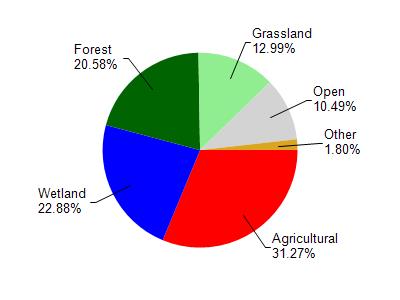Waupaca
No
No
No
Fish and Aquatic Life
Historical Description
Source: 1971, Surface Water Resources of Waupaca County
Bailey Lake, T21N, R12E, Sections 10--7, 8,
Surface Acres = 13.8; S.D.F. = 1.48; Maximum Depth = 30 feet
This hard water lake is located on the upper end of a small
tributary to McClean Creek. While a natural lake, water levels
are maintained in part by a dam located on the northeast shore.
A small inlet stream from a nearby pond and seepage provide most
of the water supplied to Bailey's Lake. Littoral bottom
materials consist of sand, muck, and marl. Largemouth bass,
perch, bluegills, black crappies, green sunfish, and brown
bullheads are the predominant species present. Investigations
indicate that the lake could support trout. A small marsh on the
southeast shore supports a significant population of muskrats. A
few puddle ducks use this lake during spring and fall migrations.
Hunting is not allowed. At the time the lake was surveyed no
public access other than a navigable water access via the outlet
was present. The shoreline has recently been subdivided,
however, and a public access site was incorporated into a public
access site was incorporated into the final plat. Three
dwellings are the only developments present on the shoreline.
Date 1971
Author Surface Water Inventory Of Wisconsin
Condition
Wisconsin has over 84,000 miles of streams, 15,000 lakes and milllions of acres of wetlands. Assessing the condition of this vast amount of water is challenging. The state's water monitoring program uses a media-based, cross-program approach to analyze water condition. An updated monitoring strategy (2015-2020) is now available. Compliance with Clean Water Act fishable, swimmable standards are located in the Executive Summary of Water Condition in 2018. See also the 'monitoring and projects' tab.
Reports
Management Goals
Wisconsin's Water Quality Standards provide qualitative and quantitative goals for waters that are protective of Fishable, Swimmable conditions [Learn more]. Waters that do not meet water quality standards are considered impaired and restoration actions are planned and carried out until the water is once again fishable and swimmable
Management goals can include creation or implementation of a Total Maximum Daily Load analysis, a Nine Key Element Plan, or other restoration work, education and outreach and more. If specific recommendations exist for this water, they will be displayed below online.
Monitoring
Monitoring the condition of a river, stream, or lake includes gathering physical, chemical, biological, and habitat data. Comprehensive studies often gather all these parameters in great detail, while lighter assessment events will involve sampling physical, chemical and biological data such as macroinvertebrates. Aquatic macroinvertebrates and fish communities integrate watershed or catchment condition, providing great insight into overall ecosystem health. Chemical and habitat parameters tell researchers more about human induced problems including contaminated runoff, point source dischargers, or habitat issues that foster or limit the potential of aquatic communities to thrive in a given area. Wisconsin's Water Monitoring Strategy was recenty updated.
Grants and Management Projects
Monitoring Projects
| WBIC | Official Waterbody Name | Station ID | Station Name | Earliest Fieldwork Date | Latest Fieldwork Date | View Station | View Data |
|---|
| 254900 | Bailey Lake | 693120 | Bailey Lake - Deep Hole | | | Map | Data |
| 254900 | Bailey Lake | 10007307 | Bailey Lake | 7/27/1999 | 9/22/2017 | Map | Data |
| 254900 | Bailey Lake | 10019363 | Baily Lake -- Access | 8/18/2018 | 8/18/2018 | Map | Data |
|

Watershed Characteristics
Bailey Lake is located in the Walla Walla and Alder Creeks watershed which is 112.09 mi². Land use in the watershed is primarily agricultural (31.30%), wetland (22.90%) and a mix of forest (20.60%) and other uses (25.30%). This watershed has 172.60 stream miles, 7,232.18 lake acres and 16,571.69 wetland acres.
Nonpoint Source Characteristics
This watershed is ranked High for runoff impacts on streams, High for runoff impacts on lakes and High for runoff impacts on groundwater and therefore has an overall rank of High. This value can be used in ranking the watershed or individual waterbodies for grant funding under state and county programs.However, all waters are affected by diffuse pollutant sources regardless of initial water quality. Applications for specific runoff projects under state or county grant programs may be pursued. For more information, go to surface water program grants.